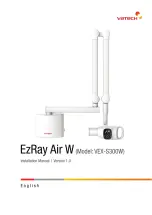
Operation
22
© Lutz-Jesco GmbH 2021
BA-22404-02-V03
Chlorine changeover unit
C 7520
Operating instructions
10 Operation
DANGER
Danger to life from leaking or incorrectly-installed
systems.
Chlorinators constitute an increased safety risk if they have not been
properly installed, if a leak test has not been performed or if the devices
are not in good condition.
ð
Before placing the system into operation, have it checked by technical
personnel to ensure that it is in the proper condition and leaktight.
ð
The condition of the installation must be checked for adequate
tightness on a regular basis.
ð
Ensure that all action is taken only by personnel with sufficient and
corresponding qualifications.
In normal operation, the device operates automatically and does not re-
quire operation. The change to the standby battery is performed automat-
ically.
10.1 Tank change
Fig. 14: Chlorine drum with auxiliary valve
To enable interruption-free dosing, the empty chlorine tank must be re-
placed by full chlorine tanks.
Precondition for action:
ü
The control indicates an empty supply battery and the LED illumi-
nates red.
ü
Full chlorine tanks are available.
Equipment required:
@
Cylinder with ammonia solution
@
New seals for the chlorine tank connections
Perform the following working steps:
1.
Close the chlorine tank valve (2).
2.
Use the injector to suck off the remaining chlorine. To do so, switch the
selection lever on the motor of the changeover unit to MAN. Switch the
changeover unit by turning the hand lever on the empty drum.
4
The pressure gauge shows the pressure of the line to the empty
chlorine drum.
i
The relay switches in the control for remote indication. Inform
the connection locations about the chlorine tank change.
3.
If the pressure gauge indicates “0”, return the selection lever to
AUTO.
4
The motor switches the ball valve to the full chlorine drum.
4.
Close the auxiliary valve (1).
5.
Interrupt the connection between the auxiliary valve and the chlorine
tank valve.
6.
Seal all open connections.
7.
Replace the empty chlorine drum with a full chlorine drum.
8.
Connect the new chlorine drum. Use a new seal.
9.
Briefly open the chlorine container valve and close it again.
10.
Perform a leakage test (see section 9.1.2 „Carrying out the leak test
with chlorine gas“ on page 20).
11.
If the leakage test does not show a leakage, open the chlorine tank
valve and the auxiliary valve.
12.
Press the OK button in the cylinder symbol.
4
The display in the cylinder symbol changes from red to green.
ü
Chlorine tank replaced.
10.2 Shutting down in an emergency
DANGER
Danger to life from chlorine poisoning!
Chlorine is poisonous. In severe cases, breathing in chlorine may lead
to death. It irritates the eyes, the respiratory system and the skin.
ð
If chlorine escapes, leave the room immediately.
ð
Use sufficient personal protective equipment.
ð
If chlorine gas escapes, wear a Type 2 self-contained breathing
apparatus that complies with EN 137.
ð
Only initiate counter measures after putting on the protective equip-
ment.
ð
Given a serious escape and insufficient equipment or qualifications,
leave the work to professional emergency services personnel. Do
not take any unnecessary risks.
The measures depend on the type of accident and should be planned and
executed by professional personnel.
10.3 Optical check
The components of the chlorination installation must be subject to a daily
visual check. Inform service personnel of anything conspicuous or a chlo-
rine smell.
2
1















































